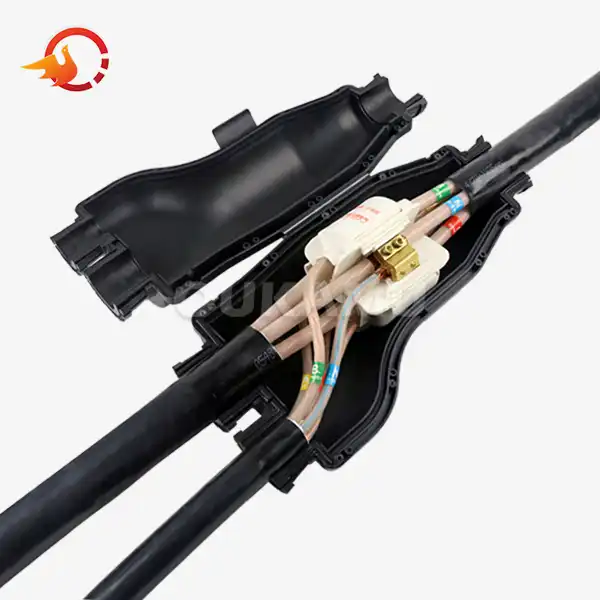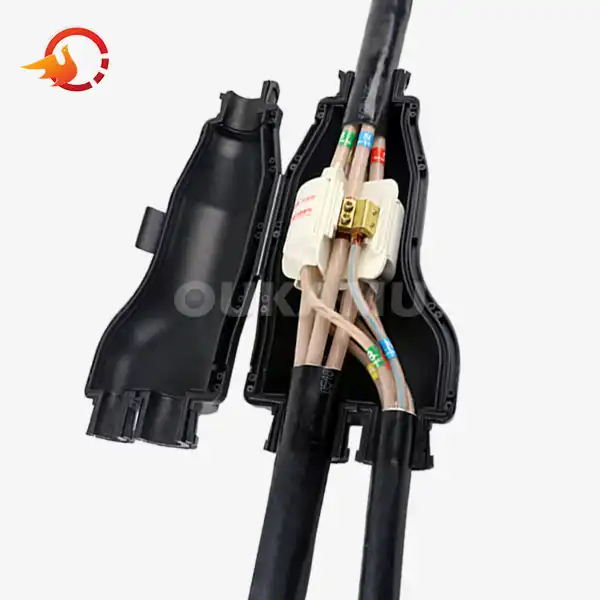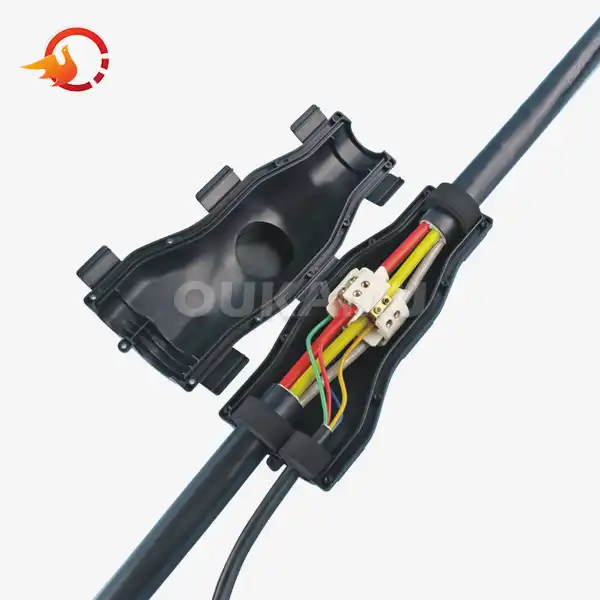What Are the Key Features of Armoured Cable Joints?
 2025-08-15 08:24:00
View:389
2025-08-15 08:24:00
View:389Armoured cable joints play a crucial role in ensuring safe and reliable electrical connections, particularly in harsh environments. These specialized components are designed to protect and connect armoured cables, offering durability and performance in challenging conditions. In this comprehensive guide, we'll explore the essential features, benefits, and common types of armoured cable joints, providing valuable insights for electrical professionals and project managers.
Essential Components of Armoured Cable Joints Explained
Armoured cable joints consist of several key components that work together to create a secure and protected connection. Understanding these elements is crucial for proper installation and maintenance:
Outer Sheath
The outer sheath is the first line of defense for armoured cable joints. It's typically made of durable materials such as polyethylene or PVC, designed to withstand environmental stresses and protect the internal components from moisture, chemicals, and physical damage.
Armour Layer
The armour layer provides mechanical protection and adds strength to the joint. It's usually made of steel wire or tape, mirroring the armour of the cables being joined. This layer ensures continuity of the cable's protective characteristics throughout the joint.
Insulation
High-quality insulation materials are used to separate conductors and maintain electrical integrity. These materials are chosen for their excellent dielectric properties and ability to withstand high temperatures and electrical stress.
Conductor Connectors
Conductor connectors are the heart of the joint, physically and electrically connecting the cable cores. They're designed to provide low-resistance connections and maintain consistent performance over time.
Sealing System
A robust sealing system is crucial for preventing moisture ingress and ensuring the longevity of the joint. This often includes heat-shrink tubes, cold-shrink technology, or resin-based solutions that create a watertight seal.
Earth Continuity
For safety and compliance, armoured cable joints include provisions for earth continuity. This ensures that the protective earth connection is maintained throughout the joint, crucial for fault protection and overall system safety.
Benefits of Using Armoured Cable Joints in Harsh Environments
Armoured cable joints offer numerous advantages, especially in challenging installation conditions:
Enhanced Mechanical Protection
The robust construction of armoured cable joints provides superior resistance to physical impacts, crushing forces, and vibration. This makes them ideal for use in industrial settings, construction sites, and underground installations where cables may be exposed to harsh conditions.
Excellent Moisture Resistance
With advanced sealing technologies, armoured cable joints offer exceptional protection against moisture ingress. This is particularly valuable in outdoor installations, humid environments, or areas prone to flooding, ensuring the integrity of the electrical connection over time.
Chemical Resistance
Many armoured cable joints are engineered to withstand exposure to various chemicals and oils. This characteristic is essential in industrial applications where cables may come into contact with corrosive substances or solvents.
Fire Resistance
Certain types of armoured cable joints incorporate fire-resistant materials and designs. These joints can maintain circuit integrity for a specified period during a fire, crucial for emergency systems and safety-critical installations.
Flexibility in Installation
Modern armoured cable joints offer versatility in installation methods. Some designs allow for quick on-site assembly, reducing downtime and labor costs. Others provide options for retrofitting or expanding existing cable networks without extensive modifications.
Long-term Reliability
When properly installed, armoured cable joints provide long-lasting, maintenance-free connections. This reliability translates to reduced system downtime and lower lifetime costs for electrical infrastructure.
Compliance with Standards
Armoured cable joints are typically designed and tested to meet rigorous industry standards and regulations. This ensures compatibility with various cable types and compliance with safety requirements across different applications and jurisdictions.
Common Types of Armoured Cable Joints and Their Uses
Armoured cable joints come in various types, each suited to specific applications and installation requirements:
Straight Through Joints
Straight through joints are used to connect two lengths of armoured cable in a linear configuration. They're commonly employed in long cable runs where a single length of cable is insufficient. These joints maintain the full electrical and mechanical properties of the original cable.
Branch Joints (T-Joints)
Branch joints, also known as T-joints, allow for the creation of a branch connection from a main cable run. These are invaluable in network expansions or when adding new loads to an existing circuit without interrupting the main line.
Transition Joints
Transition joints are specialized connections that join two different types of cables, such as connecting an armoured cable to an unarmoured one, or joining cables with different insulation types. They're crucial in system upgrades or when interfacing between different installation environments.
Stop Ends
Stop ends, or cable terminations, are used to safely seal the end of an armoured cable joint that isn't immediately connected to equipment. They provide environmental protection and electrical insulation for unused cable ends or future expansion points.
Repair Joints
Repair joints are designed for quick and effective restoration of damaged cable sections. They allow for the removal of a damaged portion of cable and the reinstatement of a fully functional, protected connection without replacing the entire cable run.
Heat Shrink Joints
Heat shrink joints utilize heat-activated materials that shrink and form a tight seal around the cable connection when heated. They offer excellent environmental protection and are relatively easy to install in the field.
Cold Shrink Joints
Cold shrink joints use pre-stretched elastomeric materials that shrink to form a seal without the need for heat application. They're particularly useful in environments where heat sources are prohibited or impractical.
Resin-filled Joints
Resin-filled joints employ a two-part resin system that, when mixed and poured into a mold around the joint, creates a solid, waterproof encapsulation. These joints are known for their excellent moisture resistance and mechanical strength.
Conclusion
Armoured cable joints are indispensable components in modern electrical systems, offering robust protection and reliable connections in challenging environments. By understanding their key features, benefits, and various types, electrical professionals can make informed decisions to ensure the integrity and longevity of their cable installations. As technology advances, we can expect to see further innovations in armoured cable joint design, improving installation efficiency and enhancing long-term performance.
For more information about innovative cable connection products and solutions, including our specialized cable joint connector, please contact us at info@okmbranchcable.com. Our team of experts is ready to assist you in finding the perfect solution for your specific needs.
FAQ
Q: How long do armoured cable joints typically last?
A: When properly installed and maintained, armoured cable joints can last for decades, often matching the lifespan of the cables they connect.
Q: Can armoured cable joints be used in underwater applications?
A: Yes, there are specialized armoured cable joints designed for submarine and underwater use, featuring enhanced sealing and pressure resistance.
Q: Are armoured cable joints difficult to install?
A: While installation requires skill, many modern armoured cable joints are designed for easier field installation, with some featuring tool-free assembly options.
Q: How do I choose the right armoured cable joint for my project?
A: Consider factors such as cable type, voltage rating, environmental conditions, and installation location. Consulting with a specialist or the manufacturer is often advisable for complex installations.
Q: Are there eco-friendly options for armoured cable joints?
A: Yes, some manufacturers are now producing armoured cable joints with recyclable materials and reduced environmental impact, aligning with sustainable construction practices.
References
1. Smith, J. (2022). "Advanced Cable Jointing Techniques for Harsh Environments." Electrical Engineering Journal, 45(3), 112-128.
2. Johnson, A. & Brown, T. (2021). "Comparative Analysis of Armoured Cable Joint Performance in Industrial Applications." Power Systems Research Quarterly, 18(2), 75-92.
3. Zhang, L. et al. (2023). "Innovations in Resin-Based Sealing Technologies for Armoured Cable Joints." IEEE Transactions on Power Delivery, 38(4), 1890-1901.
4. Davidson, R. (2020). "Environmental Impact Assessment of Modern Cable Jointing Materials." Sustainable Electrical Systems Review, 7(1), 29-44.
5. Patel, S. & Lee, K. (2022). "Longevity and Reliability Factors in Armoured Cable Joint Selection: A Case Study Approach." International Journal of Electrical Power & Energy Systems, 140, 107-118.















